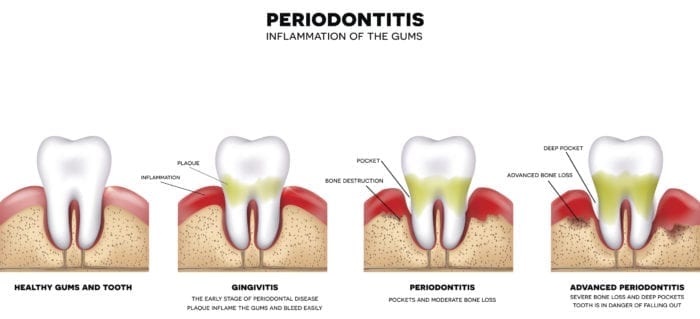Lee, Bonfiglio, Vesely and Associates provide effective treatments for bleeding gums in Annapolis MD. There is a wide spectrum of periodontal disease. It can range from gingivitis (inflammation of the gums) to periodontitis (disease of the gum, bone and other support structures of the tooth). Bleeding gums is one of the most common signs of developing gum disease.
Getting treatment for gingivitis early is essential to avoid serious problems associated with periodontitis. Tooth decay and tooth loss are two of the symptoms associated with advanced gum disease.
Gum disease is progressive and often considered a “silent disease”. So many patients do not realize they have a problem until they come in for dental care or experience complex symptoms of advanced disease. Symptoms may include loose teeth, receding gums, and changes in the fit of your bite.
What Are the Signs of Gum Disease?
Recognizing the stages and common signs of gum disease can help you get early treatment and avoid permanent damage to your gums and teeth.
- Gingivitis: early-stage gum disease is often characterized by gums that bleed, increased sensitivity to hot or cold temperature, and red swollen gums. Treating gingivitis can halt the progression of gum disease and restore gum health without the need for invasive treatment.
- Periodontitis: advanced gum disease leads to the development of pockets along the gum line where diseased tissue is pulling away from the tooth structure. This eventually leads to shifting teeth, loose teeth and changes in the fit or function of the bite.

Common reasons for bleeding gums:
- Aggressive brushing and/or flossing
- Certain medications such as blood thinners
- Pregnancy gingivitis
- Gum disease
Treatment for Bleeding Gums
Gingivitis is reversible and preventable. Your dentist can recommend changes to your daily oral care routine. We can help cut down on the amount of plaque accumulating along your gum line.
Prescription mouthwashes can also reduce the amount of harmful bacteria in your mouth. Some patients who have persistent gingivitis may need to visit the dentist every three to four months for professional cleanings that can further reduce plaque and bacteria in your mouth.
Scaling and root planing
A thorough cleaning of all surfaces. Scaling and root planing can treat gingivitis and early stages of periodontitis to remove built-up plaque and tartar from between your teeth and gums. This procedure will allow your gum tissues to heal more quickly.
Laser dentistry
Soft tissue lasers can remove damaged tissue and stimulate the body’s natural healing process. You can expect minimal discomfort and side effects. Laser dentistry is painless and quicker than traditional methods.
Oral surgery
You may need gum surgery if you have advanced periodontitis. We will remove damaged tissue, and possibly replace it with new tissue to stabilize teeth that are loose. Oral surgery is a last-resort. We will first recommend minimally-invasive treatments before oral surgery.
Bleeding Gums FAQs
Read answers to commonly asked questions about bleeding gums in Annapolis, MD:
What is the primary cause of gum bleeding?
The main cause of bleeding gums is plaque buildup along the gumline. Plaque is a sticky layer of bacteria that forms on your teeth. If you don’t remove it when you brush and floss, it can irritate your gums. Your gums can swell and bleed. This early stage of gum irritation is called gingivitis.
If plaque isn’t cleaned off, it hardens into tartar, which is much tougher to remove. Tartar can only be cleaned by a dentist or hygienist. If it’s not removed, it can make gum problems worse, leading to more bleeding and inflammation.
Can stress cause gum bleeding?
You’re more prone to experience bleeding gums as a result of stress because stress increases the amount of inflammation throughout the body. Stress also weakens the immune system and makes it harder off bacteria and infection.
What happens if you don’t treat bleeding gums?
Periodontal disease, also known as periodontitis, is a chronic gum disorder that harms the bone and tissue supporting your teeth if gingivitis is not treated. Its first symptom is typically bleeding gums. Your gums may also swell, become infected, and peel away from the roots of your teeth if you have gum disease.
Can gums grow back?
Although your gums won’t regenerate on their own, we may recommend surgery if you have gum loss. Surgery can replace the lost tissue and improve your oral health and appearance. Gum grafting is the process of attaching soft tissue from one area of the mouth to your gums.
How can you prevent bleeding gums?
Bleeding gums are often a sign of gum disease or poor oral hygiene. To prevent bleeding gums, brush your teeth twice a day with a soft-bristled toothbrush. Be gentle near the gums to avoid irritation. Use fluoride toothpaste to help strengthen your teeth and gums.
Floss before you brush. Flossing removes plaque and food particles between your teeth and along the gumline, where your toothbrush can’t reach. This helps prevent gum inflammation and bleeding. You can also use a mouthwash to reduce plaque and bacteria in your mouth and keep your gums healthy.
Remember to get a dental checkup and cleaning every six months. Our dentist can spot early signs of gum problems and help you keep your gums healthy.
Why do my gums bleed when I’m pregnant?
Your gums can bleed during pregnancy because of hormonal changes in your body. When you’re pregnant, your body produces more hormones like progesterone. This can increase blood flow to your gums.
Hormonal changes can make your gums more sensitive and prone to swelling, redness, and bleeding when you brush or floss. This condition is sometimes called “pregnancy gingivitis.”
What color are healthy gums?
Gums that are in good health should be pinkish in color and firm. This is a sign that your oral hygiene regimen is successful. However, if your gums are anything other than pink in color and firm, it’s time to see a dental professional.
When are bleeding gums serious?
If gum bleeding does not stop after 7 to 10 days, visit your dentist. You might need a deep gum cleaning to get rid of plaque and tartar and encourage gum healing. Your doctor might also request lab tests to look for vitamin deficits that might contribute to gum bleeding.
Request a Bleeding Gums Consultation
Schedule a worry-free consultation with Lee, Bonfiglio, Vesely, and Associates. After a periodontal screening and evaluation, we will recommend the best gum disease treatment option for your situation. Call (410) 268-5503 or request an appointment online today.

